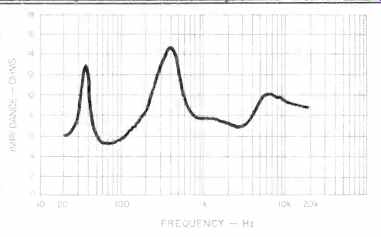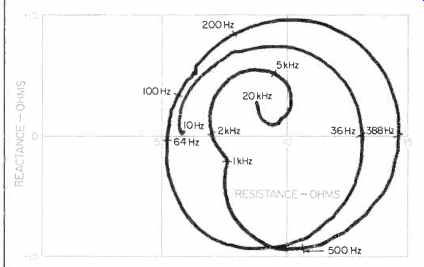Manufacturer's Specifications:
Enclosure Type: Acoustic suspension.
Drivers: 10-in. cone woofer, 4 1/2-in. cone midrange, 1-in, dome tweeter.
Frequency Response: 30 Hz to 20 kHz, ± 1.5 dB.
Sensitivity: 84 dB for 1 watt at 1 meter.
Crossover Frequencies: 520 Hz and 4 kHz.
Impedance: 8 ohms, nominal; 6 ohms, minimum.
Dimensions: 15 1/4 in. (387 mm) x 26 3/8 in. (670 mm) x 13 in. (330 mm).
Weight: 50 lbs. (22.7 kg).
Price: $449.00.
Company Address: 26 Fox Rd., Waltham, Mass. 02154, USA.
----------------------
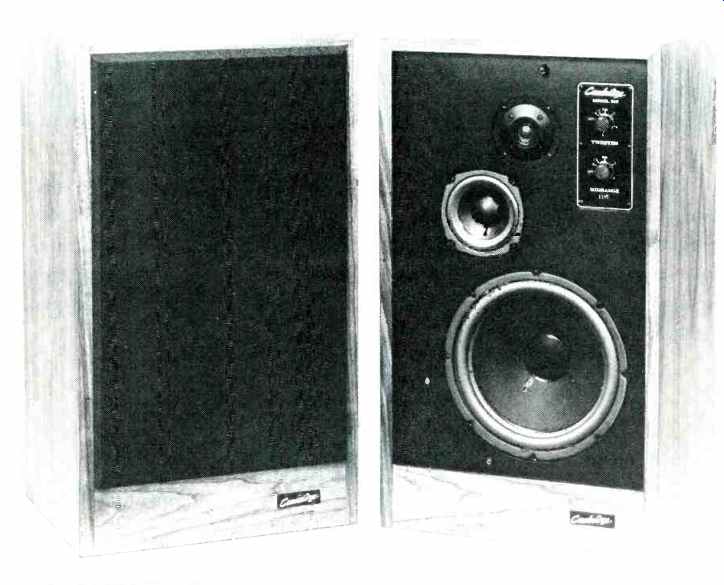
The Cambridge Physics 310 is a three-way loudspeaker system. The bass spectrum
is handled by a 10-in. woofer mounted in a sealed enclosure, a 4 1/2-in.
cone driver handles the midrange frequencies, and a 1-in. dome tweeter carries
the frequencies upward from 4 kHz.
The solidly built, oiled-walnut enclosure weighs in at nearly 50 lbs. (23 kg). Although the 310 is said by Cambridge Physics to be suitable for bookshelf placement, the system's mass seems a bit large for such application unless one has a very sturdy bookshelf. In the event that this system is mounted on a flat surface above a small child's head height, I recommend mechanically restraining the enclosures from sliding; since all sides are smooth, a firm tug on the speaker wire could bring them down on an inquisitive toddler.
The black cloth-covered grille pulls off to reveal midrange and tweeter level controls. These are scaled in decibels relative to a preferred "flat" setting and operate in a manner similar to a volume control on a preamplifier, with full counterclockwise rotation corresponding to off or no acoustic output from the driver.
Amplifier connections are made to what Cambridge Physics calls "poke-home" terminals mounted in a recessed cavity on the rear of the enclosure. Pushing down a terminal tab opens a clamp so that the wire may be poked into a hole on the rear of the terminal. Releasing the tab closes the clamp, which firmly holds the wire and provides good electrical contact. The opening is adequate for properly dressed 16-gauge wire, but barely. Larger wire sizes or poorly dressed multiple-strand wire, even of 18 gauge, can prove troublesome. The terminals are clearly identified as to polarity, and no difficulty should be encountered in hookup.
After opening the packing box and placing the 310s on the floor, I recommend sitting down and reading the excellent owner's manual which Cambridge Physics supplies with each speaker. The manual takes you step by step through proper setup and is written in a clear manner which does not require a Ph.D. in physics to understand.

Fig. 3-One-meter on-axis sound pressure amplitude for a constant-voltage
drive corresponding to 1 average watt into an 8-ohm resistor.

Fig. 4-One-meter on-axis phase response corrected for air-path delay of
(W) woofer, 3.7493 mS; (M) midrange, 3.0531 mS, and (T) tweeter, 2.9326 mS.
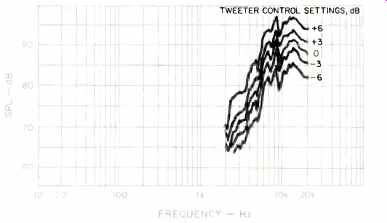
Fig. 5-One-meter on-axis anechoic sound pressure level for five tweeter
control settings, with midrange turned off.
Measurements
Impedance for the Cambridge is plotted in Fig. 1. Tweeter and midrange controls were both set to the reference level of 0 dB for this measurement. The complex impedance plot for these same settings is presented in Fig. 2.
Bass resonance occurs at 36 Hz, and the worst-case reactive load occurs around 45 Hz with a 30° phase shift. Any amplifier capable of safely driving a 4-ohm resistance to full level should be able to power the Cambridge without difficulty. Because of the substantial variation 4n impedance over the frequency range, from a minimum of 5.3 ohms to 14.8 ohms, the Cambridge should be connected to the power amplifier through low-impedance cable.
The one-meter anechoic frequency response is plotted in Figs. 3 and 4. Midrange and tweeter levels were both set at 0 dB for these measurements, while the measuring mike was located directly on the speaker's center axis. The sound pressure level, Fig. 3, is essentially uniform from a low-frequency cutoff of 27 Hz up to 5 kHz, where it quickly rises to a higher level, then remains steady up to 20 kHz.
The level of the tweeter is approximately 6 decibels hotter than the midrange and bass level. This conclusion is verified in the measurement of Fig. 5, in which the midrange control is turned completely off and the axial sound pressure level is measured at each of five major settings on the tweeter level control. In fairness to Cambridge, the user manual recommends that a setting of "0" on the control scales results in a "flat" frequency response when the speakers are properly located in a room whose reverberation time is close to optimum. Presumably, the flatness of response to which they refer is that of total sound power reaching the listener's ear. I would personally recommend that the tweeter level be reduced to the-6 dB control position for best spectral balance of direct sound if the listening position is aligned with the loudspeaker's main axis.
The phase response, Fig. 4, is corrected for three arrival times when the microphone is positioned one meter on axis.
The tweeter sound arrives at a mean average time of 2.933 milliseconds with a polarity such that a positive pulse applied to the red terminal of the loudspeaker results in a sound pressure decrease. The midrange sound arrives at 3.053 milliseconds and has an average phase of plus 90° relative to the applied voltage. The woofer energy below 1 kHz has a sound pressure which is in phase with the applied voltage and arrives at 3.749 milliseconds. Although each of the three drivers is of minimum phase type in individual sound pressure performance, the combined response of the system is non-minimum phase.
The three-meter room response for the Cambridge is shown in Fig. 6. The first 11 milliseconds of sound reaching the listening position is separated from all subsequent reverberation and weighted to prevent abrupt transitions at the beginning and end of this time window. The frequency spectrum, corresponding to this early room sound, is displayed in Fig. 6. The choice of 11 milliseconds is based on psychoacoustic data relating to pitch perception of short duration transients. The measuring microphone is placed one meter above a carpeted floor and three meters from the front of the loudspeaker enclosure. In this particular measurement, the Cambridge was raised 13 cm (5 inches) above the floor and positioned 13 cm in front of a hard surface wall. A standard 2.5-meter floor-to-ceiling height was used and no object or furniture was allowed to reflect sound energy within the 11-mS window of first sound reaching the microphone. Significant floor scatter is evident below 800 Hz when the microphone is placed directly in front of the loudspeaker, and the response rises above 5 kHz, as in the anechoic measurement.
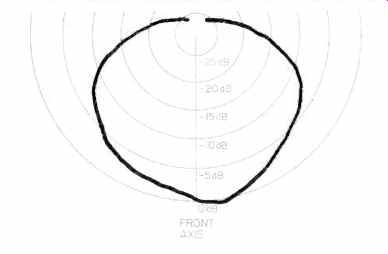
Fig. 7-Horizonal polar energy response.
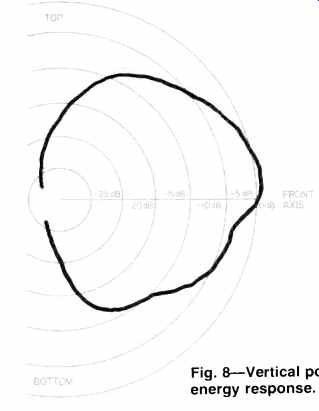
Fig. 8-Vertical polar energy response.
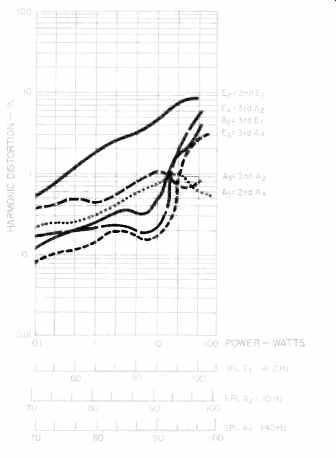
Fig. 9-Harmonic distortion for the tones E, (41.2 Hz), A2 (110 Hz), and
A4 (440 Hz).
A 30° off-axis measurement, simulating the use of this speaker as the left channel of a stereo pair, produces the lower curve in Fig. 6. (The two curves are displaced by 10 dB for clarity of presentation.) A significant response dip occurs in the 5- to 6-kHz range for this position, and is due to the drivers' placement on the front panel of the Cambridge. Floor scatter has been significantly reduced in the stereo placement, and the average response is more uniform than when seated directly in front of the speaker.
These measurements indicate that some shifting of stereo image will occur with change in frequency content and seating configuration. The implication is that the speakers should be rotated toward the listening area for best stereo imaging and the tweeter level control should be pulled back to its-6 dB position. Also, the response can benefit by raising the speaker much higher than the five inches recommended by Cambridge.
Horizontal dispersion of sound is shown in the horizontal polar energy response measurement of Fig. 7, while the vertical dispersion is shown in Fig. 8. There is a small left right asymmetry due to physical location of drivers on the front of the enclosure, but the spread of sound overall is quite good for a full 60° of listening angle. The vertical response shown indicates that the main wavefront of sound is launched slightly upward toward the normal listening position when the Cambridge is mounted near the floor.
Because of this upward response, the speaker should not be placed immediately under overhanging shelves or near similar objects which could reflect early sound back toward the listening position.
Harmonic distortion for the musical tones E, (41.2 Hz), A2 (110 Hz) and A4 (440 Hz) is shown in Fig. 9. All components remain quite low up to an average power of 30 watts.
Distortion is principally due to second-harmonic components at low level, rising toward dominance of third harmonic at highest levels.
Intermodulation distortion on A4 (440 Hz) caused by E, (41.2 Hz) when both are mixed one-to-one, is shown in Fig. 10. At low power levels the modulation on 440 Hz is principally amplitude modulation caused by the 41.2 Hz. At 10 average watts, there is approximately 8' peak-to-peak phase modulation accompanying the amplitude modulation, and at 25 average watts the phase modulation has increased by a slight amount to about 15° peak-to-peak.
There is no average advancement or retardation of the arrival time of 440 Hz due to this modulation, so the inter modulation is primarily spectral coloration rather than being time shift.
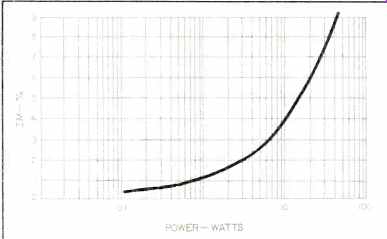
Fig. 10--IM distortion on A4 (440 Hz) caused by E, (41.2 Hz) mixed one-to-one.
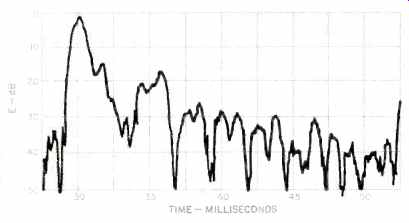
Fig. 11--One-meter on-axis energy-time response.
The Cambridge handles massed musical components quite well. In my Crescendo Test, in which a sine wave is mixed with broadband noise of 20 dB higher power level, a tone of 440 Hz suffered less than 0.1 dB modification up to combined levels of 400 watts peak instantaneous power. A middle C tone of 262 Hz was suppressed 0.5 dB at 50 peak watts and was down 1 dB at 400 watts peak, while a tone of 110 Hz remained within 0.2 dB of its proper value up to 400 watts. This shows that inner musical tones will not get lost or wander around the stereo stage during orchestral peaks.
Similarly, the Acoustic-Transfer Linearity of the Cambridge was quite uniform up to high power levels. In this test, the ratio of sound pressure level to applied voltage is used as a measure of the degree to which sound is compressed or expanded with changes in drive levels. A perfect loudspeaker will have a constant ratio of sound pressure level to applied voltage over the full power range. The Cambridge has less than 0.1 dB deviation from perfection up to 100 average watts for tones of 440 Hz and 262 Hz. A tone of 110 Hz is within 0.1 dB up to 10 average watts, then drops uniformly above this level and is down 0.5 dB at 100 watts. The handling of 60 Hz is similar to that of 110 Hz but drops to 1 dB at 100 average watts drive. Of course, all of these measurements are made for momentary transients, simulating percussive tones which the loudspeaker will be called upon to reproduce. Steady-state measurements at such high power levels would soon fry the cone, and the unnatural thermal changes thus induced would not be indicative of musical performance.
Taken in total, the harmonic, IM, Crescendo, and Acoustic-Transfer measurements indicate that orchestral tutti will be properly preserved in spatial and temporal stereo position. Some low-bass muddiness will begin to appear at very high sound levels, and instruments will tend to go bright and "blasty if ultimate power handling is quickly approached. However, there should be no changes in single instrument timbre due to changes in power levels below 10 average watts drive.
The one-meter axial energy-time curve for the Cambridge is shown in Fig. 11. The first peak is due to direct sound from the tweeter and is spectrally centered near 20 kHz, while the secondary peaks near 3.5 milliseconds are caused by enclosure edge diffractions centered around 7 kHz. Midrange energy arrivals near 3.1 milliseconds smoothly follow the early tweeter sounds. Because of the 6 decibel stronger response of the tweeter, relative to midrange and woofer levels, the tweeter carries most of the total energy for broad-band percussive sounds. In the case of the uniform-energy test signal used to generate this curve, the tweeter handles 80% of the total energy, the midrange handles 17.5%, and the rest is carried by the woofer. With the exception of the secondary diffraction peak, which could cause acoustic problems in the 2 to 3 kHz frequency range, the general shape of the energy arrivals indicates a good on-axis transient response.
Use and Listening Tests
Listening was conducted with the speakers raised five inches off the floor, as recommended by Cambridge. My first impression of the 310 overall was of a very bright top end and a solid bass, with some noticeable but acceptable midrange coloration. After experimentation, I decided that the best response, to my ears, was obtained with the speakers angled toward the listening area and the grille assembly removed. Top-end brightness was controlled by pulling down the response with preamplifier equalization, rather than reducing the Cambridge tweeter level. On some program material, piano reproduction in particular, I sensed a slight hole in the octave around middle C, which artificially colored the response to make it sound a bit more bass heavy than I would prefer. However, musical articulation with this instrument is quite good.
Stereo imaging is also quite good; though not spectacularly so. Lateralization is excellent, and the sense of depth is good, but did seem, to my ears, to produce a somewhat shortened illusion of depth.
These speakers can handle tremendous orchestral peaks without apparent strain; the bass response is particularly good. I tried listening with and without sub-bass units and felt that the Cambridge did not need low-bass help on anything but the most esoteric demonstration program material. Brass, horns, and strings are all accurately reproduced, though piano and vocals suffer in relative terms from middle- and low-register timbral problems.
On balance, the sound of the Cambridge 310 is fairly accurate, and I found that I could listen to these speakers for long periods of time without aural fatigue-which is a pretty good test for speakers you're considering living with.
This may not be the best speaker in the world, but it's pretty good for the price.
-Richard C. Heyser
(Source: Audio magazine; Nov. 1982)
Also see: Boston Acoustics A40 Speaker (July 1983)
= = = =
